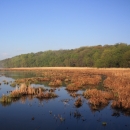About Us
Minnesota Valley Wetland Management District, established in 1988, is a 14-county district located in the transition zone between northern tallgrass prairie and eastern deciduous forest. The district manages more than 10,000 acres of land dedicated to wildlife and wildlife-dependent recreation, including more than 30 waterfowl production areas and more than 50 easements. Each of these relatively small areas – often only a couple of hundred acres – is critically important to migrating, breeding and nesting waterfowl. They also provide habitat for grassland birds, such as meadowlark and bobolink, and a variety of mammals, reptiles, amphibians and other wildlife.
Waterfowl production areas were created by an amendment to the Federal Duck Stamp Act in 1958. Scientists realized that these small pockets of habitat were vital to breeding waterfowl. This amendment gave the U.S. Fish and Wildlife Service permission to purchase small wetlands. Federal Duck Stamps are a vital tool for wetland conservation. Ninety-eight cents out of every dollar generated by the sales of Federal Duck Stamps goes directly to purchase or lease wetland habitat for protection in the National Wildlife Refuge System. Understandably, the Federal Duck Stamp Program has been called one of the most successful conservation programs ever initiated and is a highly effective way to conserve America’s natural resources.
Our Mission
The mission of the National Wildlife Refuge System is to administer a national network of lands and waters for the conservation, management and, where appropriate, restoration of the fish, wildlife and plant resources and their habitats within the United States for the benefit of present and future generations of Americans.
Every national wildlife refuge national wildlife refuge
A national wildlife refuge is typically a contiguous area of land and water managed by the U.S. Fish and Wildlife Service for the conservation and, where appropriate, restoration of fish, wildlife and plant resources and their habitats for the benefit of present and future generations of Americans.
Learn more about national wildlife refuge was created for a special purpose. Some were created to protect migratory birds, others to protect threatened or endangered species or unique habitats, while others fulfill another special purpose.
The purpose of Minnesota Valley Wetland Management District is to restore, enhance and maintain a complex of wetlands, grasslands and a limited amount of forests that provide quality habitat for waterfowl, grassland nesting birds and associated species. Secondary objectives of the district include providing wildlife-dependent recreation, wildlife interpretation, and environmental education programs to visitors and area citizens.
Our History
1988 - Minnesota Valley Wetland Management District was created and several Farmers Home Administration Easements were assigned.
June 7, 1993 - The first waterfowl production area waterfowl production area
Waterfowl production areas are small natural wetlands and grasslands within the National Wildlife Refuge System that provide breeding, resting and nesting habitat for millions of waterfowl, shorebirds, grassland birds and other wildlife. Virtually all waterfowl production areas are in the Prairie Pothole Region states of Iowa, Minnesota, Montana, North Dakota and South Dakota.
Learn more about waterfowl production area purchase agreement was made for Soberg Waterfowl Production Area.
Other Facilities in this Complex
Minnesota Valley Wetland Management District is part of Minnesota Valley National Wildlife Refuge, headquartered at the Bloomington Education and Visitor Center.
The wildlife refuge is part of a corridor of land and water stretching nearly 70 miles along the Minnesota River from Bloomington to Henderson, Minnesota. Comprised of more than 14,000 acres, the refuge spans across both rural and urban communities, and offers a variety of free outdoor recreational experiences for individuals and families.
Together, the refuge and wetland management district wetland management district
A wetland management district is a U.S. Fish and Wildlife Service office that manages waterfowl production areas in one or more counties. Waterfowl production areas are small natural wetlands and grasslands that provide breeding, resting and nesting habitat for waterfowl, shorebirds, grassland birds and other wildlife. The Fish and Wildlife Service acquires waterfowl production areas under the authority of the Migratory Bird Hunting and Conservation Stamp Act, primarily using funds from the sale of Federal Duck Stamps. The Refuge System’s 38 wetland management districts comprise thousands of waterfowl production areas – almost all in the Prairie Pothole Region of the Northern Great Plains.
Learn more about wetland management district conserve 25,000 acres of land for wildlife habitat and recreation around the Twin Cities metro area.

